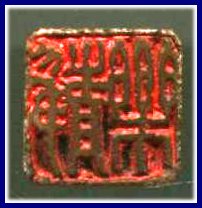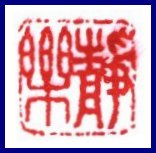











Chinese Carved Shoushan Stone Seal Contemporary Master Artist Wu Chang-shuo (1844-1927) in 1914
當代大師吳昌碩刻「靜樂」壽山石印
另一面刻文「 甲寅四月?夏由龍山人寓治石 時梅雨初晴 精神為之發? 七十一歲缶翁記」
治印年份應為1914年
Seal Carver 篆刻家
Wu Chang-shuo (1844-1927)
original name Jun, later changed to Junqing, zi Changshuo, Cangshuo, hao Foulu, Kutie, Pohe, Dalong, was a native of Anji, Zhejiang. He and his family migrated to other provinces during the Taiping Rebellion and later returned to his native place to pursue studies. At the age of twenty-two, he attained his xiucai degree and was appointed magistrate of the Andong district at the age of fifty-three. However, he left the of-fice after only one month of service, and then settled in Shanghai where he earned his living by selling paintings. He became the first chairman of the xiling Seal Carving Society which was established in1903.
Wu excelled in poetry, calligraphy, painting and seal carving. Re first followed the style of Zhao Zhiqian and succeeded in assimilat-ing the styles of Zhu Da, Shitao, Chen Chun, Xu Wei and the calli-graphic brushstrokes of various scripts into his paintings. The brushwork is precise yet expressive. Re was a close friend of the well-known painters Pu Rua, Ren Yi and Xugu and was also one of the key figures of the Shanghai School of Painting. In the art of calligraphy, he excelled in writing shiguwen (stone-drum script) with a touch of archaism in a distinctive manner.
Wu Chang-shuo (1844-1927)
also known as Junqing and Xiangbu, later known as Changshuo and Changshi, styled Foulu, Laochang and Kutian, was born in An’ji of Zhejiang. In his childhood he studied with his father and was fond of seal-cutting. He acquired basic skills of the art under the direction of his father. Then the war broke out and the family was forced to leave their native land. At the age of 21, he returned home, doing farm work while studying hard at the same time. He was devoted to the study of calligraphy and seal-cutting. Soon after he got married, he went to Hangzhou, Suzhou and Shanghai, visiting master calligraphers and seal-cutters as well as friends. He learned poetry and ci poems and philology from Yu Yuexue, and calligraphy from Yang Jian. He made friends with many painters, calligraphers, poets and collectors while he studied the genuine calligraphic works and paintings by famous artists. Gradually he attained artistry. Later he settled down in Shanghai. When he was over 30, he took great interest in painting. He asked for advice from Ren Yi, doing the painting with the strokes of seal scripts. He got together with seal-cutters like Ye Weimin and Ting Ren by West Lake in Hangzhou, discussing the art of seal-cutting. When Xiling Seal Engravers’ Society was set up in 1913, he was elected its President. He devoted himself to calligraphy, seal-cutting, painting, writing poems till his later years. He took flowers and plants as his subjects in painting, mostly plum blossoms with which he expressed his cynicism against the society. He also loved painting orchids for its purity and exclusiveness. His paintings of bamboo were light in ink, accompanied by pine trees, plum blossoms and stones with which he expressed his feelings. Another favorite subject for his painting is chrysanthemum. In his later years, he loving painting peony flowers in full blossom, brilliant and lively. The painting was done both in color and ink, vigorous and powerful, accompanied by poems in free and easy autographs and seal stamps of ancient simplicity. The painting, the autograph and the seal stamps become an integral whole. This style of his has exerted great influence upon the flower and bird paintings of the modern times. He started his studies of calligraphy with the style of Yan Zhenqing, and later he copied extensively model calligraphy represented by the tablet inscriptions of the Han Dynasty. Since his middle-age years, he studied a lot of the original inscriptions on ancient bronze and stone tablets and books of rubbings. He took characters engraved on drum-shaped stones as the models to copy from. For dozens of years, he copied and studied, and finally attained great artistry. The characters he engraved on drum-shaped stones were concise and powerful with unique style of his own. In his later years, he wrote cursive scripts with the seal style and the official style, vigorous and free in strokes. His seal-cutting had a mixed style of different schools. Since his middle-aged years, he broke away from the influences of different schools, and directly studied inscriptions on the ancient bronze and stone tablets of the Qin (221-206BC) and the Han Dynasties (221BC-220AD). Based on his studies on ancient characters, he had a good command of basic rules in seal-cutting practice, which made the structure of characters on seals not only conform to the norm, but also vary in style. His major works include “Collected Paintings of Wu Changshuo”, “Collected Works of Wu Changshuo” in addition to a collection of poems.
吳昌碩 (1844一1927)
初名俊,后改俊卿,初字香補、香圃,又字倉石、蒼石、倉碩、昌碩,一作昌石,小名鄉阿姐,號缶廬。浙江安吉人。早年生活漂泊流离,無法學習繪畫,中年以后結識書壇名家楊峴,始以篆書筆法作畫。師法沈周、徐渭、八大山人、石濤等,后受趙之謙、任伯年影響較深。他對中國畫的貢獻,是將書法、篆刻的行筆、章法、體勢融入繪畫,形成獨特的畫壇,引起美術界巨大反響。他自己也曾說,我生平得力之處在于能以作書之法作畫。" 晚年,吳昌碩毅然離開故鄉,來到文人薈莘的上海定居,初顯畫藝。果然,他取法明清大家的畫藝,又融入自己書法韻味的雄肆樸茂、氣勢磅礡的紫藤、梅花、南瓜、葡萄、雁來紅等寫意花卉畫,一鳴惊人,贏得畫壇仰戴。很快,吳昌碩在眾多的海上畫家中脫穎而出,成為清末民初"海上畫派"中的泰斗。北方著名繪畫大師齊白石對吳昌碩的金石書畫佩服之極,曾題詩:"青藤雪個遠凡胎,老缶衰年別有才,我欲九原為走狗,三家門下轉輪來。" 自從民國以來,上海畫壇"學吳"風氣,持續不斷,參加吳昌碩流派的書法家、畫家、篆刻家人數頗為壯觀。吳昌碩的金石書畫作品,早在民國時期就深受海內外觀眾的喜愛,至今仍被國際藝術市場看重,特別是日本的藝術品買家,對吳昌碩的作品偏愛之極。
吳昌碩 (1844 ~ 1927)
晚清著名畫家,書法家、篆刻家,為〝後海派〞中的代表。吳昌碩的藝術貴于創造,他以書法入畫,藝術上別辟蹊徑,齊白石曾詩道:〝我欲九原為走狗,三家(指徐渭、朱耷和吳昌碩)門下轉輪來。〞
吳昌碩原名俊,字昌碩,別號缶廬,苦鐵,浙江安吉人,70 歲後以字行。生於清道光二十四年(1844 年),卒於民國十六年(1927 年)。吳昌碩的父親是個舉人,對金石篆刻甚有研究,吳昌碩從小受到薰陶。17 歲時鬧饑荒,他在外流浪5年,回鄉後刻苦自學詩、書、篆刻、創辦〝西泠印社〞,並被推舉為社長,30 多歲跟任伯年學習繪畫。吳昌碩二十時歲中秀才,在五十三歲出任安東(今江蘇漣水)縣知事,結果只任一個多月,不願曲意逢迎,辭去官職,曾自刻印章曰〝棄官先彭譯令五十日〞。他二十九歲時曾到蘇州,在潘祖陰等人處,獲睹歷代名人書畫,精研詩、書、篆刻,自稱〝三十學詩,五十學畫〞。日本人對吳昌碩極為推崇,專門鑄造吳昌碩半身銅像,贈西泠印社陳列。
吳昌碩最擅長寫意花卉,受徐渭和八大影響最大,由於他書法篆刻功底深厚,他把書法、篆刻的行筆、運刀及章法、體勢融入繪畫,形成了富有金石味的獨特畫風,他自己說:〝我平生得力之處在於能以作書之法作畫。〞他常常用篆筆寫梅蘭,狂草作葡萄。所作花卉木石,筆力得厚老辣,力透根背,又縱橫恣肆,氣勢雄強,佈局新穎,構圖也近書印的章法布白,喜取〝之〞字和〝女〞的格局,或作對角斜勢,虛實相生,主體突出。用色上似趙之謙,喜用濃麗對比的顏色,尤善用西洋紅,色澤強烈鮮豔。
吳昌碩書法中篆書最為著名,他所臨石鼓文,參以兩周金文及秦代石刻,融合篆刻用筆。他的書法凝煉遒勁,貌拙氣酣,極富金石氣息。日本人稱讚吳昌碩為唐之後第一人,他 30 歲時求教於名重當時的畫家任伯年,以石鼓文的篆法入畫,任伯年拍案叫絕,並預言吳昌碩必將成畫壇的中流砥柱。
Other Wu's Artworks in the Collection 其他吳昌碩的作品
Click Here to See Other Contemporary Artists' Paintings
Click Here to See Other Paintings
Click Here to Go Back to Homepage